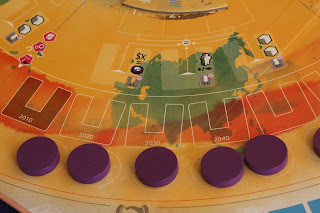RiaCon provided some time travel, between a past, measured in decades, and a brand-new present time, just like all presents use to be.
Morning began with a scheduled reunion, after something close to 35 years (!), with Fernando Zamith, former partner and opponent in the official chess competitions of Braga district (Portugal), at the end of the 1970’s, beginning of the 80’s.
To mark the occasion nothing better than a match of Petróleo, a game of that very same time. The cover of the box and the characteristic board display on the table were the reason behind several "Wow, man! The Petróleo!! ", of whom was passing by and was familiar with this or other editions.
AThen it was time for Fernando to join the Catan tournament and, later, to the Vilar de Mouros sessions, a game of his authorship.
As for me, always with the camera ready to shoot, it was time for a leap in time, to one of the games of this 2019.
That’s how I was invited to join a table in preparation for Escape Plane, one of the recent games of Vital Lacerda.
After the heist, each one must try to recover the maximum of the stash, scattered throughout the city, delude the police in pursuit and reach a safe exit.
As companions of crime, and rivals in the escape, Olavo, Adriano and Sérgio.
Many choices to make: visit locations, collect money, buy protective gear, make contacts, divert attention, try not to get noticed, evade the police, watch the rivals, plan for the final exit, even when it will be in a place unknown at the start.
And the time that is so short!
Other critical decisions will be kept in hold to later in the game. Sprint for the exit or take a riskier approach, aiming for higher gains? To play safe or to risk it all? Ambition? Greed?
I managed to get out. Saved, but not unscathed. A few wounds. Some money in the bags. Far from the success of my fellow burglars.
In the afternoon, the travels across time and space continued. Now to the Brazil from the mid-nineteenth century.
On the table the prototype of Magnanimous, already in its final stages of development. Around the table, the author, Caetano Foschini, and Paulo, already in its second go at the game.
From robber, in the morning, to a land-owner Baron in the afternoon.
Here, the game is obviously different: manage resources, export goods, contain the Paraguayan war, gain political influence, make laws pass or fail, capitalize on the influence and capacities of ministers, and ascend, ascend on the nobility scale.
With cards and dice, lots of dice, to use without rolling.
In the meantime, some conversations, a glance at the well-filled tables, the games on display, the first or secondhand sales, the raffles.
And photographs. Here are some.
 |
| Zauberei |
 |
| El Grande |
 |
| Tobago |
 |
| Trickerion |
 |
| On Mars |
 |
| CO2, Second Chance |
 |
| Wingspan |
 |
| Crokinole |
Step in and leave your PAW print - Playing Around the World - and follow the PAW tag.
Send a photo of a gaming session, the game title, your name, city, country (and, if you feel like, a short sentence about the game and or a photo of the city) to gamesinbw@gmail.com.






